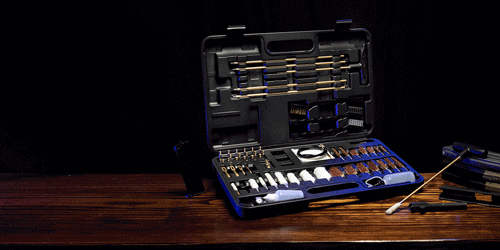How to Use a Gun Cleaning Kit
Hope our first article help you to use a gun cleaning kit. In our previous article, we explored the first 6 essential components of a gun cleaning kit. In this follow-up article, we'll cover the remaining 6 crucial parts to complete the set. By combining the information from both articles, you'll be well-equipped to effectively use our comprehensive gun cleaning kit and keep your firearms in top condition.
Cleaning Patch
Cleaning patches are essential for effectively cleaning the bore of a firearm. Using cleaning patches is a straightforward and effective method for maintaining the cleanliness and performance of your firearm.
Here’s how to use them:
Selection: Choose the appropriate size of cleaning patches for your firearm's bore. They often come pre-cut or in larger sheets that can be cut to size.
- Attachment: If using a jag or slotted patch loop, attach the cleaning patch securely to it.
- Apply Cleaner: Optionally, apply a cleaning solvent or oil to the patch to help dissolve fouling and debris.
- Insert into Bore: Insert the jag with the attached patch into the barrel from the chamber end (if applicable).
- Cleaning Motion: Push the patch through the bore using a smooth, straight motion. The patch will collect fouling as it passes through.
- Remove and Inspect: Pull the jag and patch out and inspect it for dirt and debris. If it’s dirty, replace it with a fresh patch.
- Repeat as Necessary: Continue using new patches until they come out clean, indicating that the barrel is sufficiently cleaned.
- Final Dry Pass: Optionally, run a dry patch through the barrel to remove any remaining solvent or moisture.

Cleaning Mop
A cleaning mop, often referred to as a bore mop, is used to clean and condition the bore of a firearm. Using a bore mop is a quick and effective way to clean and maintain the interior of your firearm's barrel.
Here’s how to use it effectively:
- Attachment: Connect the chamber brush to your cleaning rod, ensuring it’s securely fastened.
- Apply Cleaner: Optionally, apply a cleaning solvent to the bristles of the brush to help break down fouling.
- Insert into Chamber: Insert the chamber brush into the chamber area from the rear of the firearm (after ensuring it’s unloaded).
- Cleaning Motion: Use a gentle back-and-forth motion to scrub the chamber. This helps remove carbon buildup and debris that can affect feeding and extraction.
- Check Progress: After several passes, remove the brush and inspect it for dirt. If it’s dirty, you may need to repeat the process.
- Final Clean-Up: After cleaning the chamber, you can use a dry patch or mop to ensure it’s free of solvent and debris.
- Storage: Clean the chamber brush after use and store it properly to maintain its bristles.

Chamber Flag
A chamber flag is a safety device used to indicate that a firearm is unloaded. Using a chamber flag enhances safety and is a good practice for any firearm owner.
Here’s how to use it effectively:
- Insertion: After ensuring the firearm is completely unloaded (check the chamber and magazine), insert the chamber flag into the chamber of the firearm.
- Visibility: The bright color of the chamber flag should be clearly visible, signaling to others that the firearm is safe and unloaded.
- During Storage or Transport: Use the chamber flag when storing or transporting the firearm to prevent accidental loading and to enhance safety.
- Removal: Before using the firearm, always remove the chamber flag to ensure proper function.
- Safety Practices: Always follow safe handling practices and keep the firearm pointed in a safe direction, even when using a chamber flag.

Wire Rope
In the context of gun cleaning, a wire rope is often used as a cleaning rod alternative or for specialized cleaning tasks. Wire ropes can be effective for cleaning firearms, particularly in areas where traditional cleaning rods may struggle.
Here’s how to use it effectively:
- Selection: Choose a wire rope cleaning tool specifically designed for your firearm caliber. Ensure it is of appropriate length and flexibility.
- Attachment: If using a wire rope with a brush or jag, securely attach the cleaning component to the end of the wire rope.
- Insert into Bore: Carefully insert the wire rope into the barrel from the chamber end (if applicable). The flexibility of the wire rope allows it to navigate the bore effectively.
- Cleaning Motion: Use a smooth, pulling motion to draw the wire rope through the bore. This can help dislodge fouling and debris, especially in tighter spaces.
- Remove and Inspect: After a few passes, pull the wire rope out and inspect the attached brush or jag for fouling. If necessary, replace it and continue cleaning.
- Final Pass: Optionally, run a dry patch or mop through the barrel afterward to ensure it is free of solvent and debris.
- Storage: Clean the wire rope after use and store it properly to maintain its condition.






